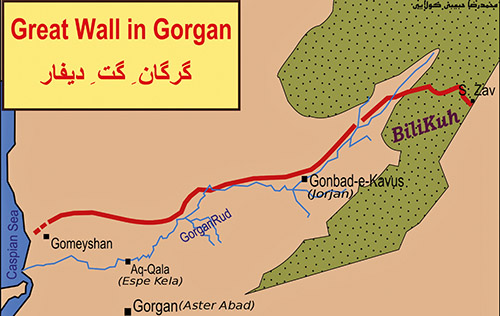
I swear, I must have written a million articles for The Link already! OK, in reality far fewer, but such exaggeration is common and Halacha recognizes it as such. If someone says “This is prohibited to me if I didn’t see on that road like those who left Egypt,” it doesn’t matter that he didn’t technically see sixty myriads, because it is understood to be an exaggeration. Other cases in the Mishna (Nedarim 24b) include seeing a snake like the beam of an olive press and a flying camel.
As for that snake, the Talmud (Nedarim 25a) questions how a snake as thick (or long) as an olive-press beam is impossible. After all, there was a snake in King Shapur’s days which was so thick that they threw 13 bundles of straw at it and it swallowed them. Shmuel (first-generation Amora, Babylonia) says that the Mishna isn’t speaking about diameter, but that it is בְּטָרוּף. The Talmudic Narrator objects that all snakes are טָרוּף, and answers that here it is טָרוּף on its back. What does טָרוּף mean? Commentaries disagree. It could mean spotted or notched. Jastrow says spotted, but notes an opinion (Rosh) that it is planed, that is, flat rather than rounded. I’d support this with the parallel Yerushalmi Nedarim (3:2) where Shmuel says that the exaggeration is that it is בִּמְרוּבַּע, with a square cross-section. Planar snakes are so shocking that even a modern-day Samuel, namely L. Jackson, would utter imprecations over it.
Did Chazal Exaggerate?
Was there really such a giant snake in King Shapur’s day, that it could consume 13 bundles of straw? The reticulated python is the longest snake in the world, at over 16 feet and the green anaconda is the thickest, at 43.7 inches diameter. Either could approximate the beam of an olive press. However, the Talmudic account sounds fantastical. Why were they throwing these straw bundles at it? Persian mythology includes the azhdaha, a great snake analogous to a dragon, and the “Shahnameh,” a Persian epic poem, describes how several heroes, including Bahram V, a Sasanian successor of King Shapur, each fought an azhdaha.
Also, it’s a red flag that there are precisely 13 bundles cast to the great snake. Consider Shabbat 119a, about Yosef Mokir Shabbat (who cherished Shabbat), who found the pearl inside the fish and sold it for 13 vessels filled with golden dinars. Rashi there cites Rabbenu HaLevi who explains it as an exaggeration, and declares that this is the case everywhere it appears, such as letters sent by Shmuel to Rabbi Yochanan explicating cases of doubtful treifa, so many that they had to be carried to Israel by 13 camels (Chullin 95b), or 13 plain staters of meat from 13 butchers which Rabbi Abba bought in honor of Shabbat (earlier on Shabbat 119a). See also Tosafot to Berachot 20a, d”h תליסר מתיבתא. Rashi takes Rav Pappa’s statement literally, where Rav Pappa declared that they learned 13 approaches to masechet Oktzin, but Tosafot describes this as exaggerated language. Thirteen thus needn’t mean exaggerated language but is a potential cue.
We might mitigate this 13 language by checking whether our girsa is accurate. Hachi Garsinan, the manuscript variant website from the Friedberg Jewish Manuscript Society, only has four texts for Nedarim 25. In our Vilna printing and the Venice printing, we have תליסר. In Munich 95 and Vatican 110, however, we have תריסר, twelve, which mightn’t indicate exaggeration. This sounds like oral error, with the liquids L/R switching off.
The parallel Yerushalmi describes the snake incident slightly differently, providing additional information. It asks, didn’t the snake of King Shapur swallow camels and carts (בְּלַע גְּמָלִין בְּלַע קָרוֹנִין)? They killed it by filling camel-bags with straw and glowing coals, which it swallowed and died. Yes, it swallowed straw, but the sense is it also swallowed the camels! (This is an inversion of the typical case of a snake-eating camel.) This doesn’t seem to be any natural snake we know of, which can point us to the mythological azhdaha or the metaphorical.
Metaphor?
Sometimes, what seems like silliness or superstition is really coded messages. Rav Schacher likes to give an example of a headline in a newspaper, “Ten Thousand Drown in a Single Drop of Ink.” describing someone signing a declaration of war, where 10,000 troops were slain on the first day of battle. Later generations, looking at the description, wouldn’t realize its poetic nature and consider it nonsense. So too, much aggadah is allegory.
If the giant snake is a metaphor, I’d assume it is in the political/military realm. The Great Wall of Gorgan is a 200 km Sasanian-era fortification system which protected them from northern peoples. Only the Great Wall of China surpasses it in length (and there, greatly, at 21,196 km). In the Turkmen language, it is called Qizil Alan, the Red Snake, because of its red bricks. Perhaps the camels and carts refer to enemy troops which were repelled in a war, and perhaps the flaming straw in camel-bags refers to some Trojan horse-like scenario.
Shapur I or II?
To better blindly guess at its meaning, we should establish whether we’re dealing with King Shapur I, from Shmuel’s time, or King Shapur II, from Rava’s time. Heinrich Guggenheimer, in his English Yerushalmi translation (available on Sefaria) notes, “A toned down version of King Sapor’s snake is in the Babli, 25a and Šebuot 29a. There, the story of the snake is discussed by Samuel, which shows that the reference is to Sapor I.” However, I’m unconvinced; a careful reading of Bavli reveals that it’s the later Talmudic Narrator who frames the question by mentioning the snake and Shapur, which leads into Shmuel’s statement. Indeed, Shmuel has no need to say דַּהֲוָה בִּשְׁנֵי שַׁבּוּר מַלְכָּא, for it’s in his own days! Shmuel could have formulated his statement separately, just as he does in Yerushalmi, where we also have the Talmudic Narrator mentioning the story and then Shmuel’s clarification of the Mishna.
There’s another clue in the parallel Yerushalmi. In exploring the Mishna’s case of seeing like the populace who left Egypt, the Yerushalmi asks, וְהָא לוּלְייָנוּס מַלְכָּא כַּד נְחַת לְתַמָּן נְחוֹת עִימֵּיהּ מֵאָה עֶשְׂרִים רִיבְּװָן, didn’t Emperor Julianus, when he went there, bring with him 12 myriads, that is, 120,000 people. Guggenheimer suggests that this refers to the “Babylonian campaign against Sapor II in the year 383 C. E.” That was then Rava’s King Shapur. Look up the Battle of Ctesiphon, where the Roman Emperor Flavius Claudius Julianus fought a battle outside the walls of the Sasanian capital. The Romans won that battle, but not the war. Julianus was eventually killed by a flying spear, and the Romans settled with the Persians on unfavorable terms. Perhaps the 120,000 troops correspond to the12 (rather than 13) bundles of straw which Shapur’s snake swallowed. The camels and carts would also be military forces destroyed by Shapur.
Aggadic Literalism
I dislike the approach by which anything my mind rejects as unlikely must be allegorical. If rationalism, and 20th-century attitudes (or 12th century attitudes, for Rambam) is the filter by which I determine what must be true, and what must be rejected—well, not rejected but reinterpreted, which is effectively rejected—then there is little Judaism has to offer that we couldn’t get from without. Especially if we also reinterpret anything we want to reject philosophically. My preference is to look to text-internal evidence that something is allegorical before declaring it so. I don’t believe in dragon-like enormous snakes, but perhaps Chazal did. It would be a disservice to them, and a lack of intellectual integrity, to wave it away as allegory. How does the text treat it?
Here, it intuitively feels allegorical, and the fantastical elements were supported with the important exaggerating number 13 (though 13 was dismissed as scribal error). There were also physical structures and historical events I could point to and kvetch a connection. However, the Talmudic text, in Bavli and Yerushalmi, treats it as literal, and evidence that such language doesn’t constitute an exaggerated vow. I’d suggest that it was understood allegorically in Rava and Shapur II’s day ( thus matching aspects of Julianus’ campaign with 12 myriads), but the account was interpreted literally by the Talmudic Narrator. See also Niddah 24b, about Tanna and Amora height, for another example of something feeling figurative (relative rabbinic stature) but taken literally (about Abba Shaul not being short despite falling into an eye-socket).
Rabbi Dr. Joshua Waxman teaches computer science at Stern College for Women, and his research includes programmatically finding scholars and scholastic relationships in the Babylonian Talmud.













